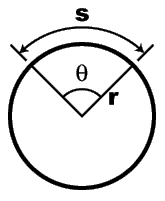The two most commonly used measures for angles are degrees and radians. There are 360 degrees in a full circle (a right angle is 90 degrees), and $2\pi$ radians in a full circle (there are $\pi/2$ radians in a right angle), so there are about 57 degrees in a radian.
Students typically learn about degrees before they learn about radians, which brings up the question: Why learn about radians if degrees are good enough for measuring angles? There are two reasons, but both are grounded in the fact that the radian is a unitless measure, which I’ll explain in the following paragraph.

The radian is defined to be (see the diagram) the ratio of the length of the arc of a circle (indicated by $s$ in the diagram) to the length of the radius of the circle (indicated by $r$ in the diagram), where each length is measured in the same unit. Therefore, when you divide $s$ by $r$ to get the radian measure of the angle, the units for the two lengths cancel, and you end up with a measure that has no units:
$\theta = \dfrac{s}{r}$
When $s$ is the entire circumference of the circle, the corresponding angle is that of the entire circle. Since the circumference of a circle is $s = 2\pi r$, the angle of a full circle is $\dfrac{2\pi r}{r} = 2\pi$.
Unless there is a good reason, one is free to use any measure whatsoever for angles, such as degrees, radians, or one of the less common ones. There are two good reasons to use radians:
1. If you are working with the derivative of a trigonometric function, then it is preferable to use radian measure for angles, because then derivative formulas (and limit formulas) are easier. For example, using radians, the derivative formulas for sine and cosine are:
$\dfrac{{\rm d}}{{\rm d}x} \sin x = \cos x$
and
$\dfrac{{\rm d}}{{\rm d}x} \cos x = -\sin x$
However, if degrees are used, the derivative formulas for sine and cosine are:
$\dfrac{{\rm d}}{{\rm d}x} \sin x = \left ( \dfrac{\pi}{180} \right ) \cos x$
and
$\dfrac{{\rm d}}{{\rm d}x} \cos x = \; – \left ( \dfrac{\pi}{180} \right ) \sin x$
The latter pair of formulas are a pain because of the additional factors, so why wouldn’t we use the simpler first pair of formulas? It’s the laziness principle that is used so often in mathematics … we always do the easiest thing. Therefore, we use radians whenever we are dealing with derivatives of trigonometric functions. (The derivatives of the other trigonometric functions are similarly simplified if radians are used … work them out, if you wish!)
2. In describing rotational motion, one rearranges the definition of radian measure to relate the linear displacement to the angular displacement:
$s = r \theta$
Differentiating both sides of this relation with respect to time (and assuming a constant radius), one obtains a relation between the linear velocity $v$ and the angular velocity $\omega$ for motion in a circle:
$v = r \omega$
If $\theta$ is measured in radians, then $\omega$ is measured in radians per second, and then the speed comes out in a natural unit; for example, if $r$ is measured in metres, then $v$ comes out in m/s. However, if $\theta$ were measured in degrees, then the units for $v$ would be m·degrees/s, which is an unnatural unit, and hard to understand.
Differentiating the relation from the previous display with respect to time once more, we get a relation between the linear acceleration and angular acceleration for an object moving in a circle:
$a = r \alpha$
A similar comment about units is also relevant here: Measuring $\alpha$ in radians/s2 means that if $r$ is measured in metres, then $a$ comes out in natural and easily understood units, m/s2. But if $\alpha$ is measured in degrees/s2, or in revolutions/s2, then the units for $a$ come out an awkward mess.
Finally, there is something arbitrary about degree measure (why 360? why not 100, or 1000, or some other round number?) that makes it aesthetically not pleasing. On the other hand, there is something aesthetically pleasing about the definition of radian measure, as it is a simple ratio. This makes it a natural measure, wouldn’t you say?
Which leads me to think about the use of the word “natural” in mathematics … it would be nice to discuss this another time.
p.s.: By the way, did you notice that the factors in the formulas for the derivatives of sine and cosine in degree measure are the same as the factor that is used to convert degrees to radians? This makes sense if you think about the conversion from degrees to radians as a scale change (i.e., a change of variable) and then use the chain rule for differentiation.
Update, 20 September 2012: Ted Burke notes in a comment to this post that Euler’s formula
$e^{i\theta} = \cos \theta + i\sin \theta$
is valid only when the angle $\theta$ is measured in radians. If the angle is measured in degrees, Euler’s formula would have to be written in the considerably uglier form
$e^{i\pi \theta / 180} = \cos \theta + i\sin \theta$
This is another situation in which radian measure is more convenient than degree measure.
Update, 28 February 2016: Parker Harris contributed a very interesting comment, which leads me to doubt that “unitless” is a good term for the radian. Perhaps “ignorable unit” is a better term, as discussed in my response to Parker’s comment.
Thanks very much to Parker for his thought-provoking comment!
(This post first appeared at my other (now deleted) blog, and was transferred to this blog on 22 January 2021.)
